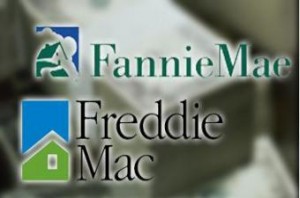 The GSEs’ mortgage portfolios are being reduced at a rapid rate with the impending total loss of their capital buffer. What does this mean for Fannie Mae and Freddie Mac in terms of a financial bailout?
The GSEs’ mortgage portfolios are being reduced at a rapid rate with the impending total loss of their capital buffer. What does this mean for Fannie Mae and Freddie Mac in terms of a financial bailout?
By the end of February, Fannie Mae’s portfolio had already contracted enough to reach its year-end-2016 goal of $339.3 billion. At the end of February, the value was $337.2 billion. According to Fannie Mae’s recently-released March 2016 Monthly Volume Summary, the mortgage portfolio had contracted by another $4.4 billion (an annual rate of 15 percent) down to $332.8 billion.
Meanwhile, the value of Freddie Mac’s mortgage-related investments portfolio at the end of February ($346.6 billion) was close to the year-end goal of $339.3 billion.
Just how much have the GSEs’ mortgage portfolios contracted? In June 2010, at the height of the foreclosure crisis, the unpaid principal balance (UPB) in Fannie Mae’s mortgage portfolio was $818 billion. Since then, the portfolio has contracted in all but four months (January 2016, March 2015, January 2015, and December 2012).
During that same nearly seven-year period, Freddie Mac’s mortgage-related investments portfolio has also declined by more than 50 percent, from $739.5 billion in June 2010 down to $346.6 billion in February 2016.
“When you're required to shrink your portfolio, and aren't allowed to build your cash reserves with whatever profits you’re making, losses—and a financial bailout—are almost inevitable.”
Rick Sharga, Ten-X Chief Marketing Officer
The fact that the GSEs are required to reduce their mortgage portfolios—both have a UPB of less than half of what it was in mid-2010—combined with a speech FHFA Director Mel Watt delivered in February 2016 at the Bipartisan Institute in which he declared that there were risks that were “certain to escalate” as long as the GSEs remained in conservatorship of the FHFA, have many analysts speculating that another taxpayer-funded bailout could happen as soon as this week.
“If we don't know where we're going with the GSEs then we shouldn't be surprised when we get there...and it doesn't turn out to be Miami Beach,” said Tim Rood, Chairman of the Collingwood Group.
Even if they GSEs do not need to draw on Treasury this quarter, the consensus seems to be that they will take a loss. Freddie Mac lost nearly a half a billion in Q3 last year, but then bounced back for a net income of $2.2 billion in Q4. While the GSEs have been profitable each year since 2012, those profits have been on the steady decline.
Analyst Richard X. Bove said when Freddie Mac releases its Q1 earnings statement on Tuesday, it is “not unrealistic to assume a loss of $2 billion plus in derivatives (it could be as high as $4 billion or more). At the $2 billion plus level, Freddie Mac’s pretax earnings would be negative $749 million.”
This week, much of the talk in the mortgage industry is around Freddie Mac and Fannie Mae and whether or not one or both will need to make another draw on Treasury when their Q1 financial results are released on Tuesday, May 3, and Thursday, May 5, respectively.
Both GSEs are required to reduce the volume of their mortgage portfolios, and both are required to have a zero capital buffer by January 1, 2018. To some, that is an extremely bad combination for taxpayers while the FHFA's conservatorship of the GSEs continues.
Add to that the fact that all of Fannie Mae's and Freddie Mac's profits have been swept into Treasury since 2012, an action that has prompted several lawsuits from GSE shareholders and investors, and for many those factors are a recipe for another taxpayer-funded bailout. And to some, it may not be a matter of if, but when.
“Whether Freddie Mac needs an infusion of cash from the Treasury or not right this minute, the bizarre way the government has structured the conservatorship almost guarantees that both Freddie Mac and Fannie Mae will eventually find themselves in financial trouble,” said Ten-X Chief Marketing Officer Rick Sharga. “When you're required to shrink your portfolio, and aren't allowed to build your cash reserves with whatever profits you’re making, losses—and a financial bailout—are almost inevitable.”

 theMReport.com Your trusted source for mortgage banking news
theMReport.com Your trusted source for mortgage banking news








